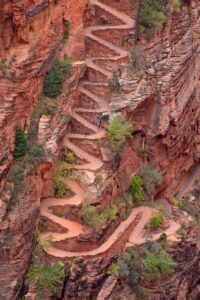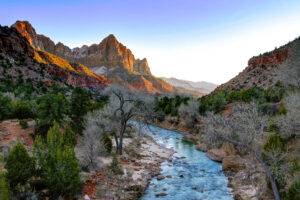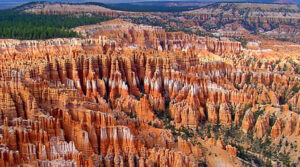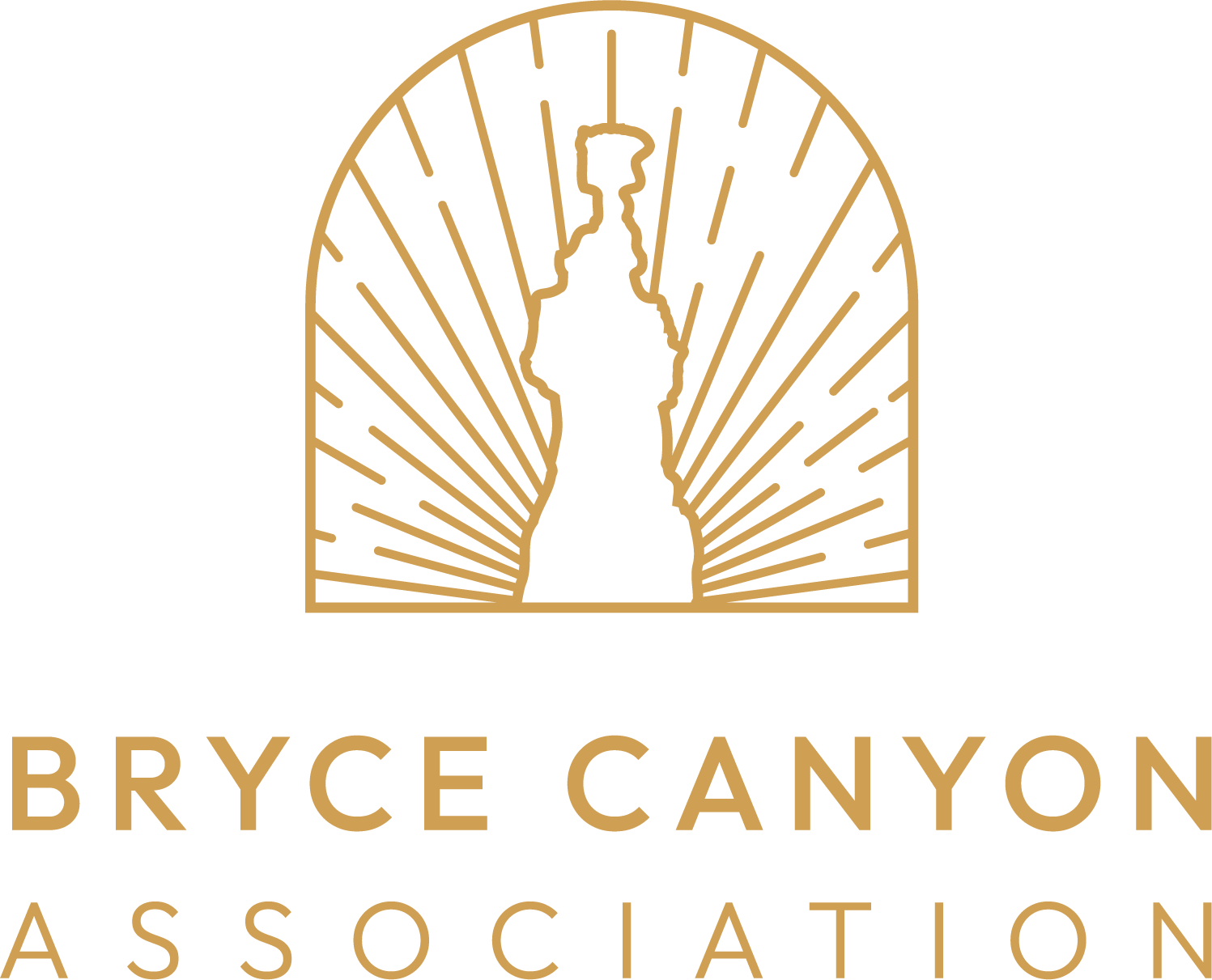Finding America in Zion and Bryce Canyon National Parks
While on a solo journey to two of the great parks of southern Utah, novelist Walter Kirn ponders how our national identity is embedded in the landscape.
by Walter Kirn
Because I arrive at night, I’m able to sense what’s around me, but not to see it. The enormity and grandeur of the landscape has to be inferred from small clues. The first is a furtive coyote, hunched and silent, that appears in my headlights and skims across the parking lot of Zion Lodge, the only hotel inside Zion National Park, in southern Utah. The second is the lodge itself, a complex of wooden structures designed in the grand manner of such refuges, with a warm, rustic lobby accented with rough stone and appointed with hickory furniture. I’ve known the aesthetic of America’s national parks since visiting Yellowstone and Glacier as a child: sturdy, substantial, egalitarian. Even the official maps and leaflets stacked in the reception area, with their handsome color photos and simple graphics, reflect this inviting, democratic design sense. For all their wondrous natural features, the parks are human places. They’re for people.
The dawn light reveals my true location, deep inside a walled valley of soaring red stone. Something about gigantic colored rocks activates the bad poet in all of us, so I’m tempted to say the stone peaks “stand sentinel†and constitute a kind of “fortress.†(What they really resemble is a mammoth jaw with colossal, eroded molars.) My goal this morning is to hike the trail to Angels Landing, a rock formation I’d heard described by a young woman in the city I had set out from—Las Vegas, the garish, unlikely base camp for so many road trips into southern Utah—as a “religious experience that’ll make you wet your pants.†How could I not be intrigued? The comment reminded me that travel, even to spots of pristine wild beauty, is never innocent of social factors; we walk in the steps of the people who’ve gone before us, testing our own impressions against theirs. I start up the trail in khakis so torn and frayed that I don’t care what happens to them.
Are rocks alive? I wonder as I climb. Yes, but they are the slowest creatures on earth. It takes them a million years to move a muscle. Passing their scratched, striated, crumbling flanks as I zigzag toward the sky, I feel the hectic thumping of my heart and realize I’m a mosquito in the scheme of things, impossibly transient and fragile. Luckily, I have lots of company today: this is a popular route. It’s a holiday weekend, and the hikers are out in force, some equipped with boots and staffs and clever backpacks containing water bladders, and some—like lazy me—wearing nothing but sneakers and old T-shirts. Many are couples. Their behavior makes me smile. One of them, often the man, acts all gung ho, pressing his panting partner to forge ahead. Later, there’s a reversal; the laggard passes the leader and takes revenge, pestering him to hurry up. Couples of all ages and races play this game, because Zion this morning is a melting pot, its demographics pleasingly diverse. A range of accents echoes off the cliffsides, Eastern, Western, Southern, urban, rural. The rocks are unresponsive. They’ve heard it all.

Walters Wiggles, on the trail to Angels Landing in Zion National Park
Halfway up a stone staircase called Walters Wiggles—one of those prewar marvels of civil engineering that typify the early National Parks—I find myself pausing to rest beside a woman who asks me where I’m from. “Montana,†I answer. It turns out she is too. She moved there from Iowa, she tells me, and I respond that my wife’s from Iowa. “Where in Iowa?†she inquires. And so it goes. There is a certain style of encounter—casual, trusting, biographical—that the national parks inspire among strangers. Here you are, a little out of breath, dressed for comfort rather than to impress and surrounded by lands and skies and waters that belong equally to all of you, and suddenly you’re inclined to open up to folks whom you might otherwise pass without a nod.
The last stretch of trail before the final lookout point atop Angels Landing is absurdly steep and perilous. Stout lengths of chain that are chilly to the touch allow you to pick your way along the precipice behind a wavering line of other hikers whose muffled exclamations of apprehension magnify your own feelings of uncertainty. You are doing your part in a collective achievement, a group triumph over nerves and vertigo. Everyone—you can feel it with every step—is fervently wishing everyone else well. When the people in front of you reach the summit, they pause to enjoy their time alone with the almost-unbearable, soul-engulfing vista, and then they turn around and grin at you. You can do it, their expressions say. It’s worth it. Then it’s your turn to gape. You’ve earned your rights, your citizenship, in the great democracy of awe.
If the National Park system has a homeland, a spiritual center, it’s here on the arid plateaus of southern Utah, where even the names of the parks feel carved from stone: Zion. Bryce Canyon. Canyonlands. Arches. Capitol Reef. The area, whose first white settlers were Mormons intent on finding a latter-day promised land, is biblical and ancient in appearance, but what modern society has done with it—reserving it for the enjoyment of the people, without distinctions for class or race or background—has made it the most American of places. Even the classic signage (brown-painted wood with rustic yellow letters) evokes a sense of shared, enduring values.

The Watchman, Zion National Park, Utah
The Watchman, one of the most iconic rock formations in Zion National Park. Getty Images
I pass through a narrow mountain tunnel as I drive east out of Zion on a twisting highway, headed for Bryce, about 80 miles away. Halfway there, I come to a tiny hamlet, Orderville, which was founded by Mormon pioneers who practiced a communal way of life known as the United Order. It didn’t last long, this form of frontier socialism based on the pooling of resources and labor, but the fact that its practitioners succeeded in gaining a foothold in this dry vastness is a small reminder that the West is not purely a region of rugged individualism. Some jobs, like blasting tunnels through solid rock or anchoring chains to high and dizzy ridges, require immense, sustained cooperative effort. Magnificent scenery builds itself. Parks don’t.
Bryce Canyon City, near the entrance of the park, sits on land that was once a private ranch. Its former owners, the Syrett family, built a resort for visitors, Ruby’s Inn, which grew over time into a sprawling complex of restaurants, cabins, and motel rooms. I stop in and look around. The gift shop is a wonder in itself, one of those charmingly silly emporiums that offer tourists a respite from too much solemn natural splendor. It includes an “Old West†photo studio, souvenir golf balls depicting red-rock spires, canyon-themed shot glasses, fridge magnets, and snow globes. Blatant all-American commercialism also has a cherished place in this landscape. I buy a coffee mug showing a rock formation that I haven’t seen in person yet and fear I may not remember clearly afterward without a little ceramic assistance.

Ten minutes later, positioned on a railed parapet, I’m gazing at the real thing: a stunningly varied profusion of spooky hoodoos rising from the sides of a great valley described in my guidebook as a “natural amphitheater.†It strikes me again that the traditional lexicon of geological wonderment could use some updating. The jagged pillars look like—what, exactly? Martian chess pieces? Rusty ballistic missiles? Petrified chicken fingers? I look at a woman standing nearby and try to imagine her thoughts about the view. Wearing a Middle Eastern–looking head scarf that she’s trying to keep from blowing off by pressing both hands against her skull, she peers toward the far horizon, at a massive wall easily 50 miles away. She may be a tourist from another nation, or perhaps an immigrant to this one. Does it matter? No. This park is common ground. America, it’s been said, is an idea—the idea that we’re all in this together, or that we had better be, or else—and here that idea feels tangible and solid, maybe even likely to endure.
The wind drives the woman from the overlook, her long dark dress flapping against her legs, but I stay put, regarding the tall pinnacles. The gusts make my eyes water and the rock forms seem to soften slightly, to erode. What do they look like? Like people. People transfixed. And though that’s a cliché, I’ll stand by it.
They look like us.
